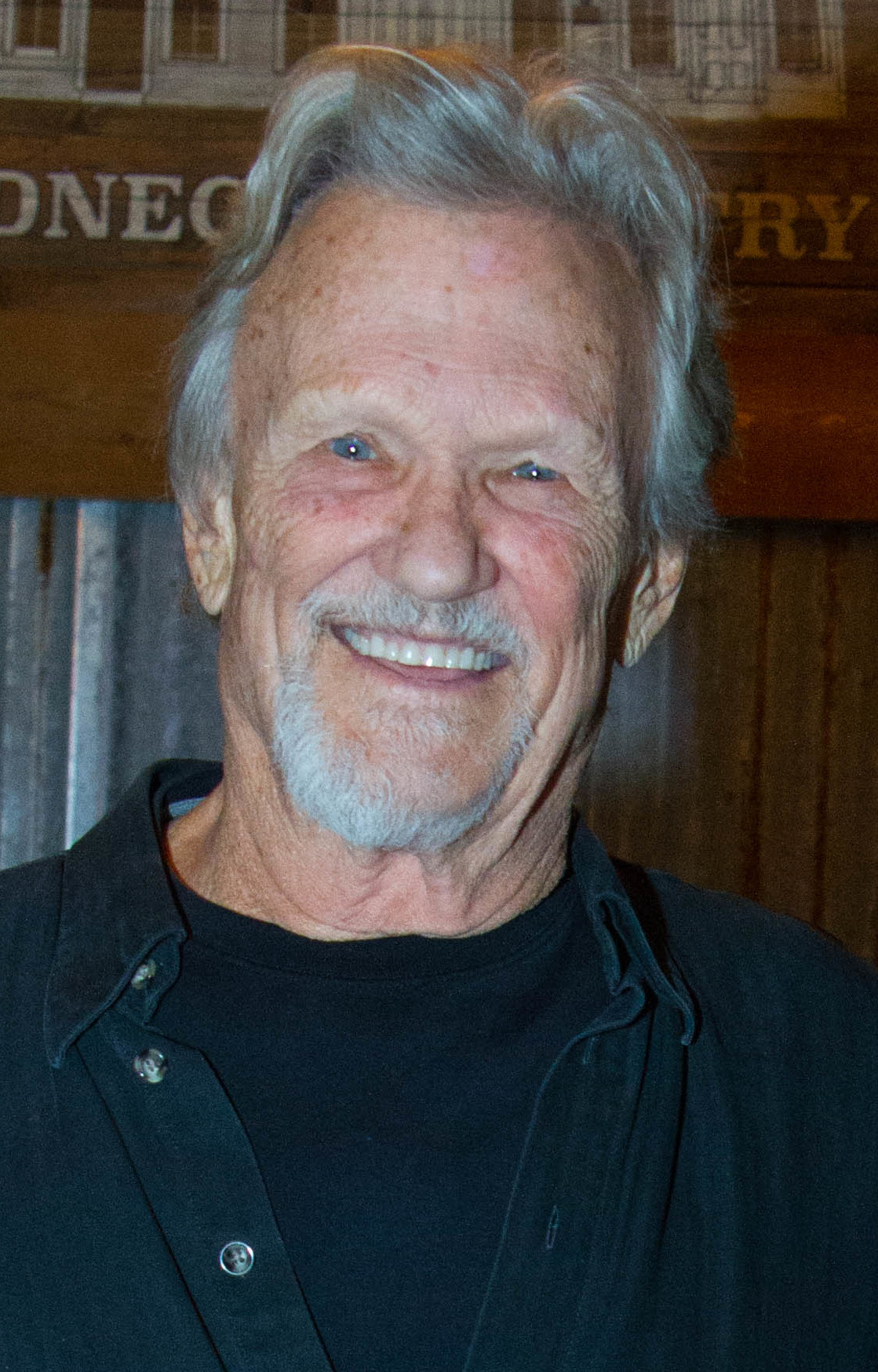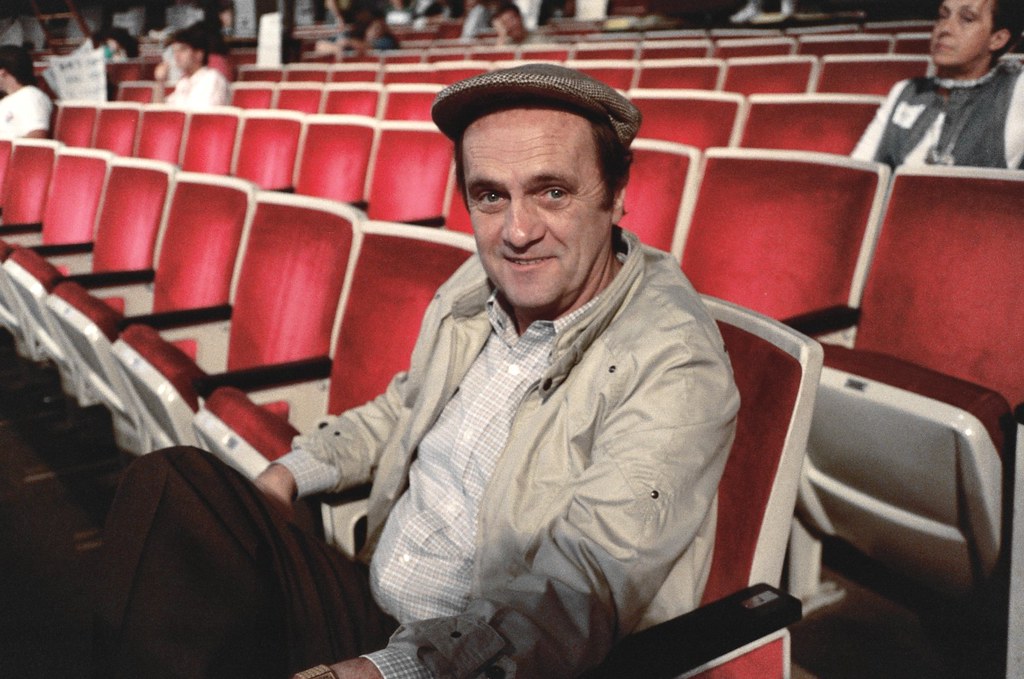
In the sprawling tapestry of American music and cinema, few figures cast a shadow as uniquely intriguing as Kris Kristofferson. His was not a linear path to stardom, but a winding odyssey that traversed academia, military service, the smoky honky-tonks of Nashville, and ultimately, the dazzling lights of Hollywood. It’s a narrative rich with unexpected turns, deeply held convictions, and an artistic integrity that defied easy categorization, resonating with the raw, introspective spirit that defined an era.
Kristofferson emerged as a pioneering voice in the outlaw country movement, a rebel against the polished Nashville sound. Yet, his influence extended far beyond music, permeating the cultural landscape as a formidable actor whose presence commanded attention. His journey from an aspiring novelist to a celebrated singer-songwriter and then an undeniable force on the silver screen reveals a relentless pursuit of authentic expression, challenging conventional molds every step of the way.
This in-depth chronicle explores the formative experiences and pivotal moments that shaped Kristofferson’s extraordinary evolution, illuminating the layered facets of a man who, despite his own humble assessment of his vocal talents, became an icon. We trace his initial aspirations, defining challenges, and the early triumphs that laid the groundwork for a career that left an indelible mark on multiple artistic domains, forever changing the landscape of American storytelling.
1. **A Rhodes Scholar’s Unexpected Path: Early Life and Military Foundation**
Born Kristoffer Kristofferson on June 22, 1936, in Brownsville, Texas, his early life was shaped by his father’s career as a United States Army Air Corps officer. Moving frequently, the family eventually settled in San Mateo, California, where Kristofferson graduated high school in 1954. A summer job on Wake Island at 17, which he called “the hardest job I ever had,” hinted at a deep-seated work ethic and resilience.
His intellect shone at Pomona College, where he majored in literature under Frederick Sontag, a significant influence. He earned recognition with prize-winning essays, “The Rock” and “Gone Are the Days,” published in *The Atlantic Monthly*. Balancing academics with demanding manual labor, he also excelled in collegiate rugby, American football, and track and field, earning a mention in *Sports Illustrated*. He graduated summa cum laude in 1958, a Phi Beta Kappa inductee.
His academic journey continued with a prestigious Rhodes Scholarship to the University of Oxford, where he earned a B.Phil. in English literature. While there, he made an early, albeit unsuccessful, attempt at a music career, signing with Larry Parnes and recording as Kris Carson. This brief foray subtly redirected his ambitions from purely literary pursuits to the possibility of a life in music.
In 1961, Kristofferson married Frances “Fran” Mavia Beer and joined the United States Army, quickly rising through the ranks. He attended U.S. Army Ranger School and completed helicopter pilot training, serving as a captain with the 8th Infantry Division in West Germany. Even amidst military duties, he formed a band, demonstrating an unwavering commitment to his artistic calling despite parental expectations for a military career.

2. **The Nashville Calling: Transition from Soldier to Songwriter**
In June 1965, a pivotal two-week leave brought Kristofferson to Nashville, Tennessee, where he contacted Marijohn Wilkin and declared his intention to become a country music songwriter. This decision meant resigning from the Army, relocating his family, and straining his relationship with parents who had envisioned a more conventional military path. Wilkin, recognizing his talent, swiftly signed him to her publishing house, Buckhorn Music, and began pitching his songs, including “Talkin’ Vietnam Blues” to Dave Dudley.
During these formative years, Kristofferson undertook a series of arduous jobs—bartender, construction worker, railroad worker—to support his artistic aspirations. Most notably, he became a janitor for Columbia Records. This unique access allowed him to interact directly with artists and be present during recording sessions, providing an unparalleled education in the craft and business of songwriting.
In 1967, his debut single, “Golden Idol” and “Killing Time,” was released on Epic Records. Though not a commercial breakthrough, this tangible step forward was a testament to his relentless commitment to music. These early efforts underscored the profound depth of his artistic conviction, laying essential groundwork for the explosive success that was just around the corner.

3. **From Janitor to Juggernaut: Early Songwriting Breakthroughs**
A significant turning point arrived in 1968, following a personal crisis involving his second child’s esophagus issues. This led Kristofferson to take a job at Petroleum Helicopters International (PHI) in Lafayette, Louisiana, flying workers to Gulf of Mexico oil rigs. The solitary nature of these flights proved fertile ground for his songwriting, with many new compositions taking shape in the skies.
The demands of this schedule were immense: flying for PHI during the week, then returning to Nashville on weekends to pitch his songs, only to fly back to Louisiana. This relentless pace exacted a heavy toll, leaving Kristofferson exhausted and questioning his career’s trajectory. Personal strains mounted, including a period when PHI “admonished him for his increased alcohol consumption,” reflecting the intense pressure he faced.
However, the tide dramatically shifted when Kristofferson received news that three of his songs had been recorded by major artists: Roy Drusky (“Jody and the Kid”), Jerry Lee Lewis (“Help Me Make It Through the Night”), and Roger Miller (“Me and Bobby McGee”). This sudden validation of his songwriting talent was a breakthrough, signaling his emergence as a formidable force in country music.
Undeterred by previous rejections, Kristofferson famously landed a helicopter on Johnny Cash’s property to ensure his material finally reached the legendary performer. This audacious move captivated Cash, leading to an invitation to a “guitar pull” party and a performance at the 1969 Newport Folk Festival. Soon after, he signed a ten-year contract with Monument Records as a recording artist and Combine Music as a songwriter. Ever humble, Kristofferson reportedly told label owner Fred Foster, “I can’t sing, I sound like a frog!”, a self-effacing remark that only added to his mystique.
4. **The Leap to the Silver Screen: Making His Film Debut**
The year 1969 marked a significant turning point as Kristofferson, following his divorce from Frances Beer, decisively moved away from Nashville to Peru. There, he embarked on his first motion picture, Dennis Hopper’s *The Last Movie*, signaling an immediate embrace of new artistic challenges even as his songwriting career was taking off. This bold leap demonstrated his willingness to explore uncharted creative territories.
While Kristofferson was immersed in filmmaking, Johnny Cash, a powerful advocate, continued to promote his original songs with other artists, ensuring his compositions reached wider audiences. Upon his return to Nashville, Kristofferson discovered a burgeoning popularity, a testament to his undeniable talent. He swiftly began work on his debut album for Monument Records, simply titled *Kristofferson*, with producer Fred Foster strategically reserving some of his material to be recorded by Kristofferson himself.
Released in June 1970, *Kristofferson* was a deeply personal album, with Kristofferson writing or co-writing every song, including “Blame it on the Stones.” Although it “was not a commercial success,” the album garnered significant critical acclaim. Robert Hilburn of the *Los Angeles Times* praised its ability to “combine lyric sophistication with country music’s traditional interest in everyday problems,” a nuanced appreciation of Kristofferson’s unique blend of intellectual depth and raw authenticity.
The critical reception and widespread recognition of his songwriting were further solidified by the commercial triumph of “Sunday Mornin’ Comin’ Down.” Johnny Cash’s iconic rendition of the song earned Kristofferson his first Country Music Association award for Song of the Year in November 1970, firmly establishing him as one of his generation’s most innovative and respected songwriters, a formidable artist whose impact was now being felt across both music and film.
Read more about: Beyond the Silver Screen: Major Harry Potter Characters Book Fans Know That Moviegoers Missed
5. **Crafting His Own Sound: The Debut Album and Early Performances**
Beyond his burgeoning songwriting fame and initial film venture, 1970 marked Kristofferson’s significant debut as a performing artist. His first appearance as a singer occurred at the legendary Los Angeles nightclub The Troubadour, a pivotal moment in establishing his identity as an interpreter of his own profound compositions, not just a writer of hits for others. This live presence added another dimension to his rapidly expanding artistic persona.
Hollywood’s interest in his unique charisma was growing, leading to an invitation from Fred Roos to audition for a leading role in Bob Rafelson’s *Two-Lane Blacktop*. In an anecdote that underscored his unconventional nature, Kristofferson, then signed to Columbia Records, “arrived to the appointment intoxicated and left,” seemingly ambivalent to the traditional demands of the acting world.
Despite this missed opportunity, his raw talent remained undeniable. Kristofferson was soon offered Bill L. Norton’s script for *Cisco Pike* by Columbia. Eschewing advice from peers to “take acting lessons instead,” he accepted the role, explaining his decision with an intuitive understanding: “I read the script and I could identify with this cat.” He further articulated his acting philosophy, stating that it is “understanding a character, and then being just as honest as you can possibly be,” highlighting a natural, unstudied approach.
His intense 18-month tour during this period pushed him to his limits. He battled severe walking pneumonia, a condition “worsened by his alcohol consumption,” leading to periods where he “would not face the audience and mumbled the words to his songs,” and eventually requiring hospitalization. Yet, even amidst these struggles, his star continued to ascend, notably performing on *The Johnny Cash Show*, cementing his connection to the very heart of American music and setting the stage for his dual-career trajectory.
6. **Establishing His Cinematic Presence: “Cisco Pike” and Beyond**
Returning to Nashville in early 1971 after a period in California where he befriended Janis Joplin, Kristofferson encountered a profoundly moving moment. Among his mail at Combine Music, he received Joplin’s posthumous album, *Pearl*, which included a powerful cover of his own composition, “Me and Bobby McGee.” This poignant recording not only further elevated his status as a songwriter but also forged an enduring, bittersweet link between his work and Joplin’s legendary voice.
Fueled by this emotional experience and his continuing creative surge, Kristofferson promptly returned to the studio. His second Monument album, *The Silver Tongued Devil and I*, was released in July 1971. This collection showcased his prolific talent, featuring nine of his own songs, including the impactful single “Lovin’ Her Was Easier (than Anything I’ll Ever Do Again).” He also expanded his collaborations, working with Shel Silverstein on “The Taker” and Donnie Fritts on “Epitaph (Black and Blue),” demonstrating his versatility.
“Lovin’ Her Was Easier” proved to be a notable commercial success for Kristofferson as a performer, reaching number 46 on the *Billboard* Hot 100 and an impressive number 4 on the Adult Contemporary charts. This widespread appeal highlighted his ability to craft songs that resonated across genre boundaries, connecting with a diverse and growing audience who were now actively embracing his unique vocal style and storytelling prowess.
The momentum from his successful second album seamlessly intertwined with his burgeoning film career. The songs from *The Silver Tongued Devil and I* were prominently featured on the soundtrack for *Cisco Pike*, which premiered on January 14, 1972. This film marked his first major starring role, firmly establishing his dual identity as a musician and an actor. His visibility was further enhanced by an appearance with singer Rita Coolidge at the 1972 Dripping Springs Reunion, foreshadowing a significant personal and professional partnership to come.
7. **Grammy Glory and Musical Milestones: A Rising Star in Music**
The early 1970s saw Kristofferson’s musical journey ascend to new heights of critical acclaim and commercial recognition. February 1972 brought the release of his third album, *Border Lord*, a collection of new material that initially experienced “sluggish sales.” However, this period was also defined by immense industry validation, as Kristofferson “swept the Grammy Awards that year with numerous songs nominated,” winning the prestigious Country Song of the Year award for “Help Me Make It Through the Night,” firmly establishing him as a master songwriter.
His fourth album, *Jesus Was a Capricorn*, initially faced a similar fate of “slow sales.” Yet, its trajectory dramatically changed with the release of the third single, “Why Me.” This song became an undeniable success, propelling album sales significantly. “Why Me” ultimately sold “over one million copies” and earned a gold disc certification from the RIAA on November 8, 1973, marking a watershed moment where Kristofferson firmly established himself as a major recording artist in his own right.
Kristofferson’s growing public profile was further amplified by an appearance with Rita Coolidge on the BBC television series *The Old Grey Whistle Test*, where they performed “Help Me Make It Through the Night,” extending his international reach. Concurrently, the enduring quality of his compositions was underscored as soul artist Al Green released his acclaimed version of “For the Good Times” on the album *I’m Still in Love with You*, showcasing Kristofferson’s cross-genre appeal.
April 1973 brought a unique honor: an honorary doctorate in fine arts from Pomona College, a testament to his burgeoning artistic influence. This recognition was made even more special by the presence of Johnny Cash and Rita Coolidge. Four months later, his personal life intertwined with his professional as he married Coolidge. The duo then released their album *Full Moon*, which became another commercial success, “buoyed by numerous hit singles and Grammy nominations,” solidifying their powerful artistic and personal partnership.
The year 1973 saw Kris Kristofferson at a significant crossroads, with critical acclaim for his songwriting and growing recognition as a recording artist alongside Rita Coolidge. Yet, the path ahead was anything but predictable, as he navigated the complex currents of Hollywood stardom, musical experimentation, and an unyielding commitment to personal conviction that would define the rest of his extraordinary career. From the silver screen’s dazzling heights to the dusty roads of political activism, Kristofferson’s journey continued to unfold with a captivating blend of artistry and authentic rebellion.
This next chapter delves into the period of his commercial zenith, the powerful collaborations that shaped his sound, the formation of an iconic supergroup, and his sustained influence across film and music, culminating in his enduring legacy and final years. It’s a testament to a man who, despite the demands of fame, consistently prioritized integrity and artistic freedom.
8. **The Ascent to Movie Star Status: A Star Is Born and Convoy**
While Kristofferson was enjoying musical success with Rita Coolidge, his acting career was about to explode into mainstream consciousness. His distinct, rugged charisma and unvarnished honesty made him a natural fit for the silver screen, even as his solo music struggled commercially. This period, marked by the release of his fifth album, *Spooky Lady’s Sideshow* in 1974, ironically became a turning point for his film career, setting the stage for his undeniable presence in Hollywood.
His role in the 1976 remake of *A Star Is Born*, starring opposite Barbra Streisand, was a monumental event that firmly cemented his status as a leading man. This film was a critical and commercial triumph, earning him a Golden Globe Award for Best Actor in a Musical, a clear testament to his burgeoning star power. The film’s success brought Kristofferson unparalleled visibility, far surpassing the reach of his solo musical efforts at the time.
Following this career-defining role, Kristofferson continued to tackle diverse cinematic projects. He starred in Sam Peckinpah’s action classic *Convoy* in 1978, further showcasing his rough-hewn charm and ability to command the screen. Even as his distinctively rough voice and anti-pop sound limited his own musical audience, his compelling performances ensured his material found widespread success through other artists, like Willie Nelson, whose 1979 LP *Willie Nelson Sings Kristofferson* reached number five on the U.S. Country Music chart and went Platinum.

9. **Navigating Artistic Evolution: Solo Work and the End of a Partnership**
The commercial failure of *Spooky Lady’s Sideshow* in 1974 marked a significant shift in Kristofferson’s musical trajectory as a solo artist. Despite the critical praise that often accompanied his releases, his own distinctive vocal style and introspective sound often proved challenging for the broader mainstream audience. This trend continued for much of his subsequent solo musical career, even as artists like Ronnie Milsap and Johnny Duncan continued to achieve chart success with his compositions.
However, the collaborative spirit that defined his early career persisted, especially with Rita Coolidge. After their successful *Full Moon* album, they released *Breakaway* in 1974 and *Natural Act* in 1978, continuing to blend their voices in a harmonious partnership that resonated with fans. These albums were often “buoyed by numerous hit singles and Grammy nominations,” solidifying their presence as a prominent musical duo of the era, even as their personal relationship navigated its own challenges.
Beyond their joint efforts, Kristofferson continued to explore diverse musical ventures. In 1979, he notably traveled to Havana, Cuba, to participate in the historic Havana Jam festival, sharing the stage with a galaxy of international and Cuban artists. This adventurous spirit, documented in Ernesto Juan Castellanos’s film *Havana Jam ’79*, underscored his willingness to cross cultural and musical boundaries, showcasing his enduring passion for authentic expression.
The decade concluded with a memorable appearance alongside Rita Coolidge on *The Muppet Show* in November 1979, an endearing moment that highlighted their widespread appeal across different entertainment platforms. Tragically, their marriage eventually concluded with their divorce in 1980, marking the end of a significant personal and professional chapter in Kristofferson’s life, but not the end of his artistic journey.

10. **The Highwaymen: Forging a Supergroup Legacy**
Following his divorce from Rita Coolidge in 1980 and a period of focusing on his film career, Kris Kristofferson’s musical path took an electrifying turn. After marrying Lisa Meyers in 1983, he re-engaged with music in a monumental way, particularly through his enduring partnership with Willie Nelson. Their collaboration culminated in their joint appearance in the 1984 film *Songwriter*, for which Kristofferson received an Academy Award nomination for Best Original Score, and its accompanying successful album, *Music from Songwriter*.
This creative synergy with Nelson laid the groundwork for one of country music’s most iconic formations. By 1985, Kristofferson and Nelson were joined by two other titans of outlaw country, Waylon Jennings and Johnny Cash, to form the supergroup simply known as The Highwaymen. This collective was far more than a casual gathering; it was a powerful convergence of four distinct voices that defined an era of country music.
The Highwaymen’s self-titled debut album, released on May 6, 1985, was an instant success. Its lead single, a powerful rendition of Jimmy Webb’s “Highwayman,” resonated deeply with audiences and became an instant classic, awarded the ACM’s Single of the Year in 1985. This supergroup not only offered Kristofferson a renewed platform for his musical talents but also solidified a lasting legacy that underscored his place among country music royalty.

11. **Reinvention in Cinema: From Lone Star to Blade**
Even as The Highwaymen flourished, Kristofferson’s solo recording career experienced a dip in the early 1990s. However, this period marked a profound reinvigoration of his acting career, showcasing his versatility and enduring appeal on the silver screen. It was John Sayles’ 1996 film *Lone Star* that truly reignited interest in Kristofferson as an actor, proving his ability to deliver powerful, nuanced performances that resonated with critics and audiences alike.
This resurgence led to a string of significant and often surprising roles. He found a new generation of fans through his portrayal of Abraham Whistler, the grizzled vampire hunter mentor to Wesley Snipes’ Blade, in the *Blade* film trilogy (1998, 2002, 2004). These films, with their unique blend of action and supernatural elements, allowed Kristofferson to tap into a darker, more intense side of his acting prowess, garnering widespread recognition.
His filmography during this period became impressively diverse, demonstrating his range and demand in Hollywood. From co-starring with Steven Seagal in *Fire Down Below* (1997) to appearing in *A Soldier’s Daughter Never Cries* (1998), *Payback* (1999), Tim Burton’s remake of *Planet of the Apes* (2001), *The Jacket* (2005), and *Fast Food Nation* (2006), Kristofferson consistently delivered memorable performances, proving that his cinematic presence was as vital as ever. This prolific output cemented his position as a respected character actor with an undeniable screen presence.
12. **Enduring Musical Output and Acclaim: A Legacy of Song**
Throughout the late 1990s and into the 21st century, Kris Kristofferson continued to cultivate a rich musical legacy, even as his film career thrived. In 1999, he released *The Austin Sessions*, an album that saw him reinterpreting some of his most beloved songs with the help of acclaimed artists like Mark Knopfler, Steve Earle, and Jackson Browne. This project offered a fresh perspective on his classic material, reminding listeners of the profound depth and timeless quality of his songwriting.
Despite undergoing coronary artery bypass surgery shortly after the album’s release, Kristofferson’s commitment to creating new music remained unwavering. He followed up with *This Old Road* in 2006, his first album of new material in 11 years, which was met with critical praise. Subsequent albums like *Closer to the Bone* (2009) and *Feeling Mortal* (2013) further showcased his introspective songwriting and distinct vocal delivery, proving that his artistic wellspring was far from dry.
Kristofferson’s enduring impact was recognized through numerous prestigious awards and honors during these later years. He was inducted into the Nashville Songwriters Hall of Fame in 1977 and the Songwriters Hall of Fame in 1985, acknowledging his pivotal role in shaping American music. In 2004, he received the ultimate honor in country music, induction into the Country Music Hall of Fame, a testament to his profound influence on the genre. He also earned the “Spirit of Americana” Free Speech Award in 2003, the Johnny Mercer Award in 2006, and was honored as a BMI Icon in 2009, reflecting his widespread artistic and cultural significance. His career was crowned with the Grammy Lifetime Achievement Award in 2014, recognizing his contributions as a three-time Grammy winner from thirteen nominations, including a nomination for his 2016 album, *The Cedar Creek Sessions*.
13. **A Voice for Justice: Enduring Advocacy and Political Stance**
Beyond his artistic achievements, Kris Kristofferson was consistently an outspoken advocate for social justice, using his platform to champion causes close to his heart. His commitment to peace and human rights was evident in his vocal opposition to the Gulf War and Iraq War, as well as his criticism of various U.S. military interventions and foreign policy positions, including support for the Contras and the Apartheid government in South Africa. This stance, though sometimes controversial, was deeply rooted in his personal experiences and convictions.
Kristofferson famously described himself as a “dove with claws,” a descriptor that perfectly encapsulated his blend of anti-imperialist views and pride in his military service. He initially supported the Vietnam War but became a staunch opponent after hearing harrowing accounts from returning soldiers, stating, “The notion that you could make a young person do something so inhumane to another soldier—or even worse, a civilian—convinced me that we were in the wrong.” This transformative experience solidified his lifelong commitment to speaking truth to power, regardless of the personal cost.
His advocacy extended to supporting the United Farm Workers, where he appeared at numerous rallies and benefits, campaigning alongside Cesar Chavez. He also performed in benefit concerts for Leonard Peltier and Palestinian children, demonstrating his global humanitarian concerns. His unwavering commitment to his beliefs, even when it meant facing public backlash or “a considerable lack of work,” as he noted, underscored his integrity. Notably, at a Bob Dylan anniversary concert in 1992, he showed solidarity with Sinead O’Connor when she was booed, exemplifying his courage to stand with those who dared to challenge the status quo. His politically aware album, *Repossessed* (1986), featuring the tribute “They Killed Him,” further enshrined his heroes like Martin Luther King Jr., Jesus, and Mahatma Gandhi, reflecting his deep moral compass.
Read more about: Peter Yarrow, The Enduring Voice of Peter, Paul and Mary, Dies at 86: A Retrospective on a Folk Icon’s Formative Years and Profound Impact

14. **The Final Curtain Call: Retirement and Lasting Legacy**
After decades of an extraordinarily prolific career spanning music and film, Kris Kristofferson announced his retirement from performing in January 2021, citing age and concerns related to the COVID-19 pandemic. His manager, Tamara Saviano, noted that this decision was “an evolution, and it just felt very organic,” a natural progression for an artist who had given so much of himself to the world. It marked the end of an era, but his influence would continue to resonate.
His final public performance was a poignant moment, taking place at the Hollywood Bowl on April 29, 2023, during Willie Nelson’s 90th birthday celebration. There, he joined Rosanne Cash for a moving rendition of “Lovin’ You Was Easier,” a bittersweet farewell to the stage that highlighted the deep bonds of camaraderie and artistry he shared with his peers. This performance, captured in the concert film *Long Story Short: Willie Nelson 90*, served as a fitting coda to his live career.
Kris Kristofferson passed away peacefully in his Hana, Hawaii, home on September 28, 2024, at the age of 88. His family chose not to provide a cause of death, honoring his private nature even in his final moments. Tributes poured in from across the globe, with Dolly Parton, Reba McEntire, Miranda Lambert, Willie Nelson, and Ashley McBride among countless others who paid homage to his immense talent and indelible spirit, acknowledging the profound impact he had on their lives and on the landscape of American culture.
In a final, eloquent testament to his lifelong pursuit of freedom and authentic expression, Kristofferson had requested that the first three lines of Leonard Cohen’s “Bird on the Wire” be inscribed on his tombstone:
*Like a bird on the wire*
*Like a drunk in a midnight choir*
*I have tried in my way to be free*
Read more about: Gene Kelly’s Final Curtain: A Deep Dive into His Later Years, Private Choices, and Enduring Legacy
These words perfectly encapsulate the essence of Kris Kristofferson: a free spirit, an outlaw poet, and a tireless artist who, in his own unique way, always sought liberation through his music, his acting, and his unwavering commitment to a more just world. His legacy is not just in the hits he wrote or the films he graced, but in the spirit of authenticity he embodied, forever challenging, forever inspiring. His was a life lived vividly, fiercely, and with an unshakeable belief in the power of truth and art.











